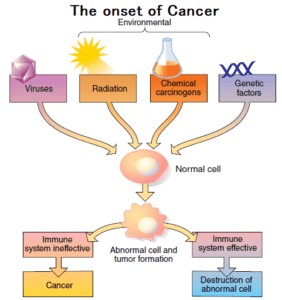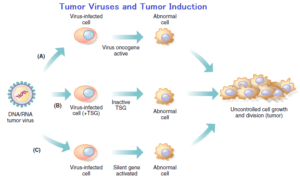Viruses associated with Human Tumors and Cancers
Cancer is indiscriminate. It affects humans and animals, young and old, male and female, rich and poor. In the United States, some 560,000 people die of cancer annually, making the disease the third leading cause of death after heart disease and stroke.
Worldwide, almost 8 million people die of cancer each year, two-thirds in developing nations. Cancer is a very complex topic, so we will only summarize the general concept and emphasize the important points related to viruses.
Cancer is an uncontrolled growth and spread of cells
Cancer results, in part, from the uncontrolled reproduction (mitosis) of a single cell. The cell escapes the cell cycle’s controlling factors and, as it continues to multiply, a mass of cells soon forms. Eventually, the cluster yields a clone of abnormal cells referred to as a tumor.
Normally, the body will respond to a tumor by surrounding it with fibrous connective tissue called a capsule. Such a local tumor is designated benign because it usually does not spread to surrounding tissue. Additional changes can occur to tumor cells that release them from their origins. The tumor cells might break out of the capsule and metastasize, a spreading of the cells to other tissues of the body.
Such a tumor now is described as malignant, and the individual now has cancer (cancer = “crab”; a reference to the radiating spread of cells, which resembles a crab). How can such a mass of cells bring illness and misery to the body? By their sheer numbers, cancer cells invade and erode local tissues, interrupt normal functions, and choke organs to death by robbing them of vital nutrients. Thus, the cancer patient will commonly experience weight loss even while maintaining a normal diet.
Oncogenic viruses influence cancer development
Some cancer researchers believe that about 65% of all human cancers are the result of genetic factors. Many of the remaining cancers are associated with carcinogens, which are chemical and physical agents that produce cellular changes leading to a tumor and cancer. The Ames test, is designed to use bacterial cells to detect potential chemical carcinogens in humans.

Health experts suspect that about 12% of human cancers globally are associated with viruses, the majority caused by human papillomaviruses (HPVs) and the hepatitis B and C viruses. In all, at least six viruses are associated directly or indirectly with human tumors and cancers.
When these oncogenic (tumor-causing) viruses are transferred to test animals or cell cultures, an observable change in the morphological, biochemical, or growth patterns of normal cells takes place. This cellular transformation involves a complex, multistep sequence of events, of which viruses play one part. Immune system activity, chronic inflammation, and mutagens usually are additional factors required for malignant transformation.
| Human Oncoviruses and Their Effects on Cell Growth | |||
| Oncogenic Virus | Effect | Benign Disease | Associated Cancer |
| DNA Tumor Viruses | |||
| Papillomaviridae • Human papillomavirus (HPV) |
Encodes genes that inactivate cell growth regulatory proteins | Benign warts
Genital warts |
Cervical, penile, and oropharyngeal cancer |
| Papovaviridae • Merkel cell polyomavirus (MCPV) |
Being investigated | Unknown | Merkel cell carcinoma |
| Herpesviridae • Epstein-Barr virus (EBV) |
Stimulates cell growth and activates a host cell gene that prevents cell death |
Infectious mononucleosis | Burkitt lymphoma Hodgkin lymphoma Nasopharyngeal carcinoma |
| Herpesvirus 8 (HV8) | Forms lesions in connective tissue | Growths in lymph nodes | Kaposi sarcoma |
| Cytomegalovirus (CMV) | Stimulates genes involved with tumor signaling |
Mononucleosis syndrome | Salivary gland cancers |
| Hepadnaviridae • Hepatitis B virus (HBV) |
Stimulates overproduction of a transcriptional regulator | Hepatitis B | Liver cancer |
| RNA Tumor Viruses | |||
| Flaviviridae • Hepatitis C virus (HCV) |
Chromosomal aberrations, including enhanced chromosomal breaks and sister chromatid exchanges | Hepatitis C | Liver cancer |
| Retroviridae • Human T-cell leukemia virus (HTLV-1) |
Encodes a protein that activates growth stimulating gene expression |
Weakness of the legs | Adult T-cell leukemia/ lymphoma |
oncogenic viruses are found only in some families composing the DNA viruses (DNA tumor viruses), which have dsDNA genomes, and the Retroviridae (RNA tumor viruses), which have dsDNA when integrated as a provirus in a host cell. The most common virus-associated malignancy among women is uterine cancer, caused by certain groups of human papillomaviruses (HPVs) in the Papoviridae.
In men, liver cancer, caused by the hepatitis B virus (Hepadnaviridae), is the most common. One further point is that there might be other, yet unidentified viruses that also are associated with human cancers. On the positive side, individuals can be vaccinated to prevent infection by HPV and hepatitis B virus, and there are antiviral drugs available that reportedly can cure hepatitis C infections. Thus, the incidences of cancer caused by these viruses have been declining.

Oncogenic viruses are thought to cause tumors in three ways:
Oncogene Activity: One way the cellular transformation process is mediated is by proteins encoded by oncogenes, which are viral genes that some members of the Retroviridae possess. On infection of a human cell, integration and expression of the viral oncogene convert a normal cell into a tumorous or cancerous cell. These genes usually affect growth control, cell division, or chemical signaling involved in cell growth.
Gene Suppression: Cellular transformation can occur through the loss of normal gene activity. Normal cells contain several tumor suppressor genes (Tsgs), the function of which is to inhibit transformation; that is, if a cell attempts to convert to an abnormal cell, the tumor suppressor proteins trigger a programmed cell death (cell suicide) called apoptosis. However, if a provirus integrates near a TSG, the close association with the TSG can cause the loss of tumor suppressor protein function, resulting in uncontrolled cell divisions.
Gene Activation: If a provirus integrates near a transcriptionally “silent” gene, the close association might activate the silent gene. If the gene normally helps control cell division or cell growth, its activation can permanently “turn on” the synthesis of growth-promoting proteins, again leading to uncontrolled cell division. This ability of viruses to get inside cells and deliver their viral information or influence host cell genetic information has been manipulated through genetic engineering to deliver genes to cure genetic
illnesses.
This ability of viruses to get inside cells and deliver their viral information or influence host cell genetic information has been manipulated through genetic engineering to deliver genes to cure genetic illnesses.
Tumor Viruses Do not always Cause Cancer
Not everyone infected with an oncogenic virus develops cancer. Human cells have division controls and checkpoints that must be disrupted for malignant transformation to occur. In fact, a variety of factors, including environmental, diet, and lifestyle, as well as host genetics contribute to the transformation process. In addition, immune system status and surveillance are critical in determining if cancer might develop. Thus, tumor virus infection is only one part of cancer development.
Reference and Sources
- https://www.researchgate.net/publication/263585267_Viruses_and_Human_Cancers_a_Long_Road_of_Discovery_of_Molecular_Paradigms
- https://en.wikipedia.org/wiki/Cancer
- https://quizlet.com/201402100/microbiology-exam-3-flash-cards/
- https://en.wikipedia.org/wiki/Carcinogenesis
- https://quizlet.com/63953721/chapter-14-flash-cards/
- https://quizlet.com/241870473/ch-15-the-viruses-and-virus-like-agents-flash-cards/
- https://www.bayer.com/en/news-stories/from-magic-spells-to-precision-medicine-the-history-of-cancer-care
Also Read:
- Mesothelioma Lung Cancer
- Bacterial Growth Curve: Definition, Phases and Measurement
- Third Golden Age of Microbiology
- Classification of viruses on the basis of genome
- Tissue Transplantation Rejection
- What is Gene Expression?
- Mutations: Introduction, Types, Causes and Repair Mechanisms
- Roles of Viruses In Aquatic Ecosystems
- Proteins: Definition, Roles, Functions and Structure
- Tools of Genetic Engineering to Make Genome Modifications
- Comparison Between the Domains Bacteria, Archaea, and Eukarya
- Reverse Transcription Polymerase Chain Reaction (RT-PCR)
